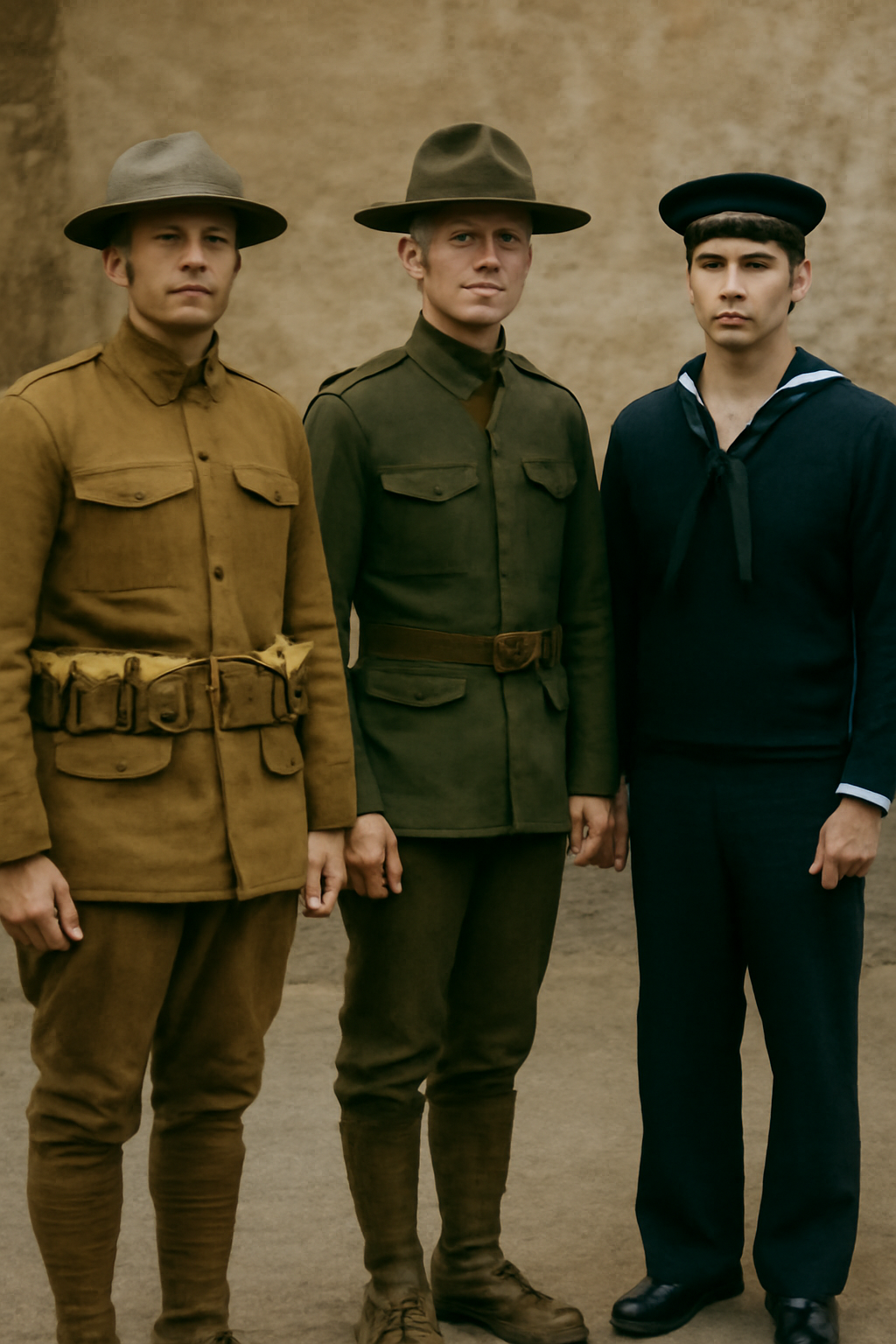
"US Military Uniforms in WWI: Army, USMC & Navy Gear Explained"
Published on May 25, 2025
WWI US Uniforms: The Complete History of American Military
Introduction: America's Uniform Revolution in WWI
When the United States entered World War I in April 1917, the military faced an enormous challenge: outfitting nearly 4 million men in proper uniforms within months. The resulting transformation from peacetime dress to wartime practicality created some of the most iconic American military uniforms in history.
This guide covers:
- The Army's transition from the 1912 service uniform to the standardized M1917 doughboy outfit
- Marine Corps distinctions including their famous dress blues and combat adaptations
- Navy uniform innovations that balanced shipboard practicality with military formality
- Detailed uniform components from headgear to footwear and everything between
- Insignia and rank systems unique to each branch
- Specialized gear for different climates and combat roles
Whether you're a military historian, collector, reenactor, or simply fascinated by this pivotal era, you'll find authoritative information presented in clear, engaging detail.
The Evolution of WWI Army Uniforms
The Pre-War Uniform (1912 Pattern)
Before American entry into the war, soldiers wore the M1912 service uniform featuring:
- Olive drab wool tunic with stand-up collar and four brass buttons
- Matching breeches designed for mounted troops
- Spiral wool puttees (leg wraps) replacing earlier canvas leggings
- Distinctive campaign hat with Montana peak crease
- Brown leather equipment including the Mills cartridge belt
This uniform reflected 19th century influences but proved impractical for modern trench warfare.
The Standardized M1917 Uniform
After declaring war, the Army WW1 implemented crucial changes:
- Simplified tunic design for mass production
- Introduction of the M1917 helmet (modified British Brodie design)
- Replacement of puttees with canvas leggings
- New wool overcoat with detachable liner
- Gas mask bag became standard issue
Specialized Uniforms
- Tank Corps: One-piece coveralls with padded helmets
- Aviation: Leather flying coats and fur-lined gear
- Medical Corps: Red cross armbands and special insignia
Marine Corps Uniforms - Tradition Meets Warfare
The Legendary Dress Blues
The USMC maintained its distinctive blue uniforms throughout the war:
- Dark navy wool tunic with red piping
- High standing collar with quatrefoil ornamentation
- White trousers for summer wear
- Dress blues medals including:
- WWI Victory Medal
- French Fourragère
- Croix de Guerre
Combat Adaptations
In the trenches of France, Marines modified their gear:
- Replaced dress shoes with trench boots
- Added protective gear like gas mask satchels
- Modified insignia for field conditions
Marine Corps Footwear
- Dress shoes: Russet leather with toe caps
- Field shoes: High-lace combat boots
- Special care requirements for leather in wet conditions
Navy Uniforms - Functionality at Sea
Service Dress Options
The Navy maintained multiple uniform types:
- Winter blues: Double-breasted wool jacket
- Summer whites: Cotton duck uniform
- Service khakis: Practical tropical wear
Shipboard Innovations
- Denim working uniforms for dirty tasks
- Specialized footwear with non-slip soles
- Rank insignia variations for different uniforms
Landing Party Gear
When sailors fought ashore, they carried:
- Web belts with ammunition pouches
- Steel helmets adapted from Army models
- Specialized packs for naval infantry
Uniform Components in Detail
Headgear Through the War
- Campaign hats to steel helmets
- Officer's visor caps vs. enlisted covers
- Specialty hats for different roles
The Science of Wool
- Weight variations by season
- Dye formulas and color consistency
- Care and maintenance in field conditions
Footwear Evolution
- From ankle boots to trench shoes
- Sole patterns for different terrains
- Repair techniques used at the front
Insignia and Identification
Rank Structure Visualized
- Chevron systems comparison
- Officer insignia materials
- Warrant officer distinctions
Unit Markings
- Division patches introduction
- Shoulder sleeve insignia
- Numbering systems decoded
Documentation Systems
- Service records connection
- Uniform issue logs
- Modification records
Collecting and Preservation
Authenticity Verification
- Stitching patterns to examine
- Fabric analysis techniques
- Marking deciphering guide
Proper Conservation
- Climate control requirements
- Moth prevention methods
- Cleaning techniques for vintage wool
Display Recommendations
- Mannequin selection
- Lighting considerations
- Documentation presentation
Conclusion: The Legacy of WWI Uniforms
The uniforms of the American Expeditionary Forces represent a fascinating intersection of tradition and innovation. These garments tell the story of how the U.S. military transformed itself from a small professional force to a modern army capable of global operations.
Key takeaways include:
- The rapid standardization of Army uniforms showed American industrial efficiency
- Marine Corps tradition preservation demonstrated service identity
- Navy practical adaptations reflected changing naval warfare
For historians and collectors, these uniforms provide tangible connections to the brave Americans who served in "the war to end all wars." Their design influences can still be seen in modern military attire, making this a pivotal moment in uniform history.
